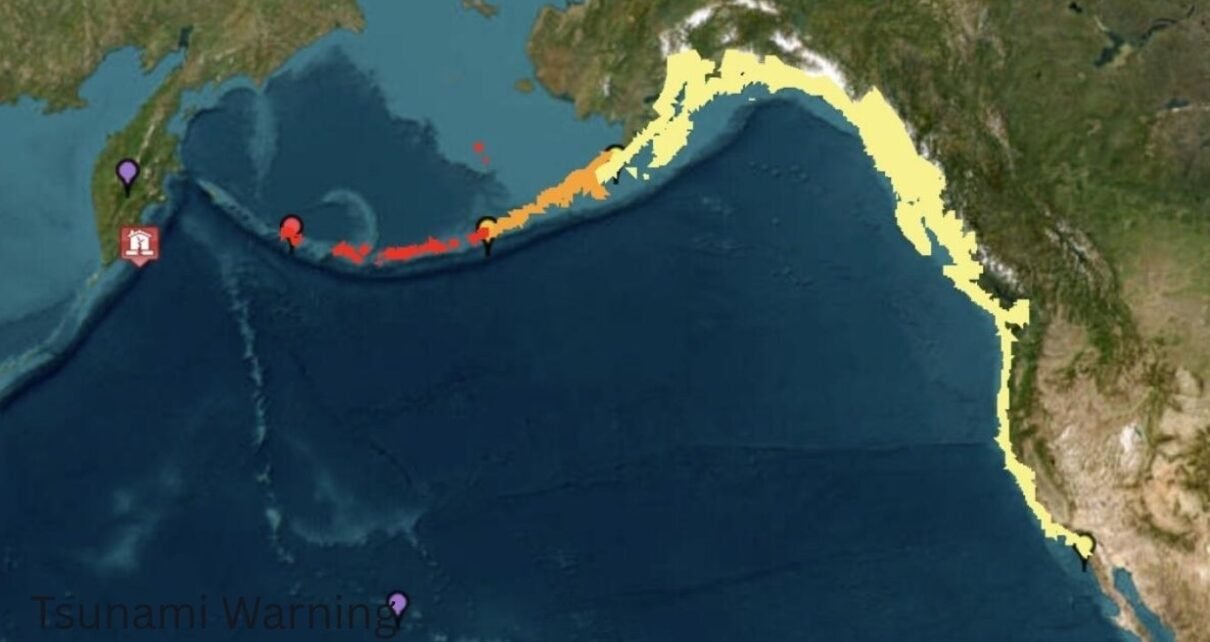a massiveTsunami Warning earthquake registering magnitude 8.7 struck off the coast of the Kamchatka Peninsula in Russia’s Far East. The quake triggered tsunami warnings across Russia, Japan, Alaska, Hawaii, Guam, and parts of Micronesia. This seismic event—among the strongest in recent decades—prompted swift evacuations and raised global awareness about preparedness along Pacific coastlines.
Seismic Details & Timeline
| Detail | Description |
|---|---|
| Magnitude (revised) | 8.7 (originally reported as 8.0) |
| Epicentre Depth | Approximately 19 km beneath the seabed |
| Distance from Coast | ~126 km from Petropavlovsk‑Kamchatsky |
| Time of Occurrence | Early hours of July 30, 2025 (UTC) |
| Expected Tsunami Height | Up to 4 metres near Russian coast |
| Affected Regions | Russia, Japan, Alaska, Hawaii, Guam |
| Injuries Reported | Several minor, mostly during evacuations |
The earthquake’s shallow depth and high magnitude significantly increased its tsunami-generating potential. It was followed by multiple aftershocks over the next several hours.
Regional Impact & Response
Russia: Kamchatka Peninsula
Coastal settlements, especially around Severo-Kurilsk, were evacuated as authorities predicted tsunami waves as high as 4 metres. A local kindergarten suffered minor damage, but reported injuries were limited to minor cases during the evacuation process.
Japan: Northern Coastal Zones
Tsunami advisories were issued for northern Japan, including areas in Hokkaido and northern Honshu. Waves of up to 3 metres were expected, prompting coastal evacuation procedures even though the epicentre was far offshore.
U.S. West Coast & Pacific Islands
Authorities in Hawaii, Alaska, Guam, and parts of California, Oregon, and Washington issued tsunami watches and evacuation alerts. Residents were urged to stay clear of coastal areas and move inland until wave predictions were updated. As wave levels were recalculated and found to be lower than first estimated, most warnings were lifted after a few hours.
Scientific Context: Subduction Zone Tremors
The event occurred along a known tectonic boundary where the Pacific plate subducts beneath the Okhotsk plate, forming part of the Pacific Ring of Fire. This region is prone to repeated, powerful earthquakes. The 8.7 magnitude quake made it one of the most significant recent events along with past quakes in the 1950s and 1960s that caused widespread tsunamis.
Historical Precedents
A few past events in this seismic region illustrate the potential risk:
- In 1952, a magnitude 9.0 quake near Severo-Kurilsk generated tsunami waves exceeding 18 metres, resulting in over 2,000 fatalities.
- In the 1960s, magnitude 8.5 quakes in the Kuril Islands caused destructive waves across the Pacific.
- Earlier in 2025, a magnitude 7.4 quake triggered a brief tsunami alert in the same region, though no waves materialised.
These historical tremors underline a recurring cycle of seismic activity and demonstrate why preparedness remains essential in the Pacific basin.
Immediate Aftermath
- Structural Damage: Limited, with one kindergarten damaged in Russia.
- Casualties: Only minor injuries reported due to evacuation procedures.
- Public Response: Rapid evacuation protocols were activated across affected regions.
- Aftershocks: A series of smaller tremors followed, prompting continued monitoring.
- Global Alerts: Warnings issued across Pacific regions were later downgraded based on wave assessments.
Expert Assessment
Seismologists and disaster management experts noted:
- The Tsunami Warning quake’s shallow epicentre combined with ocean-floor displacement contributed to tsunami risk.
- That shaking intensity near major cities was relatively moderate, avoiding large-scale structural failures.
- The event highlights the critical importance of early-warning systems, public education, and evacuation readiness in coastal regions.
- Even in regions distant from the epicentre, inter-regional coordination and monitoring remain essential to minimize risks.
- The series of aftershocks reinforces the need for continued readiness and communication across emergency systems.
FAQs
1. How frequent are such powerful quakes in Kamchatka?
The region lies on a major tectonic plate boundary and routinely experiences magnitude 7+ earthquakes, including several in the past century.
2. Why were Tsunami Warning alerts extended to Japan, Hawaii, and Alaska?
Ocean-borne seismic waves can travel large distances. As a precaution, alert systems were activated across all Pacific coastlines.
3. Were there casualties or major damage?
No major damage or fatalities were reported. A few injuries occurred during evacuations; damage was minimal and localised.
4. How strong must an earthquake be to generate a tsunami?
Typically, earthquakes of magnitude 7.5–8.0 or more, especially those with shallow sea-floor epicentres, have potential to trigger tsunamis.
5. What coastal safety measures should India consider?
India should invest in coastal warning systems, evacuation protocols, public disaster education, and community drills—especially along eastern seaboard zones.
6. Should tsunami alerts in India be taken seriously?
Yes. India’s coastal areas are vulnerable to distant seismic events. Public awareness and infrastructure readiness are key to preventing loss.
7. Are aftershocks expected following such a quake?
Yes. Multiple aftershocks are normal, though their intensity typically decreases over time.
8. What long-term lessons does this quake offer for Indian planners?
It underscores the value of resilient infrastructure, early-warning capabilities, collaborative coordination between agencies, and investment in community preparedness.
Conclusion
The 8.7 magnitude earthquake off Russia’s Kamchatka coast is a potent reminder of the Pacific’s seismic volatility. While damage was thankfully limited this time, the event stresses the need for constant vigilance, prompt evacuation planning, and strong disaster response mechanisms. For India’s coastal population and decision-makers, the incident is a powerful lesson in global seismic interconnectivity and the importance Tsunami Warning of preparedness.



